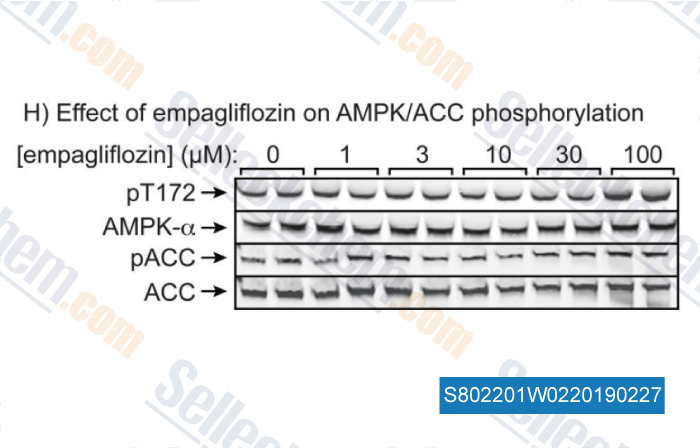|
Toll Free: (877) 796-6397 -- USA and Canada only -- |
Fax: +1-832-582-8590 Orders: +1-832-582-8158 |
Tech Support: +1-832-582-8158 Ext:3 Please provide your Order Number in the email. |
Technical Data
| Formula | C23H27ClO7 |
||||||
| Molecular Weight | 450.91 | CAS No. | 864070-44-0 | ||||
| Solubility (25°C)* | In vitro | DMSO | 90 mg/mL (199.59 mM) | ||||
| Water | Insoluble | ||||||
| Ethanol | Insoluble | ||||||
| In vivo (Add solvents to the product individually and in order) |
|
||||||
|
* <1 mg/ml means slightly soluble or insoluble. * Please note that Selleck tests the solubility of all compounds in-house, and the actual solubility may differ slightly from published values. This is normal and is due to slight batch-to-batch variations. * Room temperature shipping (Stability testing shows this product can be shipped without any cooling measures.) |
|||||||
Preparing Stock Solutions
Biological Activity
| Description | Empagliflozin is a potent and selective SGLT-2 inhibitor with IC50 of 3.1 nM, exhibits >300-fold selectivity over SGLT-1, 4, 5 and 6. Phase 3. | ||
|---|---|---|---|
| Targets |
|
||
| In vitro | Empagliflozin shows >2500-fold selectivity for hSGLT-2 over hSGLT-1 (IC50 8300 nM) and >3500-fold selectivity over hSGLT-4, it exhibits >350-fold selectivity over hSGLT-5 (IC50=1100 nM) and >600-fold selectivity over hSGLT-6. No relevant inhibition of GLUT1 is observed up to 10 μM Empagliflozin. In a kinetic binding experiments, [3H]-empagliflozin displays a high affinity for SGLT-2 with a mean Kd of 57 nM in the absence of glucose, and shows a half-life of [3H]-empagliflozin-binding to SGLT-2 of 59 min in the absence of glucose.Its binding to SGLT-2 is competitive with glucose. [1] | ||
| In vivo | High exposure of empagliflozin is achieved in dogs, with plasma concentrations >100-fold above IC50 measured 24 h after administration of 5 mg/kg empagliflozin. The total plasma clearance of empagliflozin in ZDF rat is 43 mL/min/kg, while in dogs is lower at 1.8 mL/min/kg. Cmax of empagliflozin in ZDF rat and dogs is 167 nM and 17254 nM, respectively. [1] Terminal elimination half-life in ZDF rat and dogs is 1.5 h and 6.3 h, respectively. Bioavailability of empagliflozin in ZDF rat is 33.2%, while in dogs is higher at 89.0%. Long-term treatment with empagliflozin, improves glycaemic control and features of metabolic syndrome in diabetic rats. [2] |
Protocol (from reference)
| Kinase Assay:[1] |
|
|---|---|
| Cell Assay:[3] |
|
| Animal Study:[1] |
|
References
|
Customer Product Validation

-
Data from [Data independently produced by , , Diabetes, 2016, 65(9):2784-94]
Selleck's Empagliflozin has been cited by 32 publications
| Empagliflozin improves mitochondrial dysfunction in diabetic cardiomyopathy by modulating ketone body metabolism and oxidative stress [ Redox Biol, 2024, 69:103010] | PubMed: 38160540 |
| Empagliflozin attenuates hypoxia-induced heart failure of zebrafish embryos via influencing MMP13 expression [ Biomed Pharmacother, 2024, 180:117453] | PubMed: 39332186 |
| SGLT2 inhibitors attenuate endothelial to mesenchymal transition and cardiac fibroblast activation [ Sci Rep, 2024, 14(1):16459] | PubMed: 39013942 |
| Identifying novel aryl hydrocarbon receptor (AhR) modulators from clinically approved drugs: In silico screening and In vitro validation [ Arch Biochem Biophys, 2024, 754:109958] | PubMed: 38499054 |
| Kidney glycolysis serves as a mammalian phosphate sensor that maintains phosphate homeostasis [ J Clin Invest, 2023, 133(8)e164610] | PubMed: 36821389 |
| Targeting high glucose-induced epigenetic modifications at cardiac level: the role of SGLT2 and SGLT2 inhibitors [ Cardiovasc Diabetol, 2023, 22(1):24] | PubMed: 36732760 |
| Empagliflozin targets Mfn1 and Opa1 to attenuate microglia-mediated neuroinflammation in retinal ischemia and reperfusion injury [ J Neuroinflammation, 2023, 20(1):296] | PubMed: 38082266 |
| Empagliflozin reduces podocyte lipotoxicity in experimental Alport syndrome [ Elife, 2023, 12e83353] | PubMed: 37129368 |
| Multi-omics analysis reveals attenuation of cellular stress by empagliflozin in high glucose-treated human cardiomyocytes [ J Transl Med, 2023, 21(1):662] | PubMed: 37742032 |
| Targeting unfolded protein response reverts ER stress and ER Ca2+ homeostasis in cardiomyocytes expressing the pathogenic variant of Lamin A/C R321X [ J Transl Med, 2023, 21(1):340] | PubMed: 37217929 |
RETURN POLICY
Selleck Chemical’s Unconditional Return Policy ensures a smooth online shopping experience for our customers. If you are in any way unsatisfied with your purchase, you may return any item(s) within 7 days of receiving it. In the event of product quality issues, either protocol related or product related problems, you may return any item(s) within 365 days from the original purchase date. Please follow the instructions below when returning products.
SHIPPING AND STORAGE
Selleck products are transported at room temperature. If you receive the product at room temperature, please rest assured, the Selleck Quality Inspection Department has conducted experiments to verify that the normal temperature placement of one month will not affect the biological activity of powder products. After collecting, please store the product according to the requirements described in the datasheet. Most Selleck products are stable under the recommended conditions.
NOT FOR HUMAN, VETERINARY DIAGNOSTIC OR THERAPEUTIC USE.
